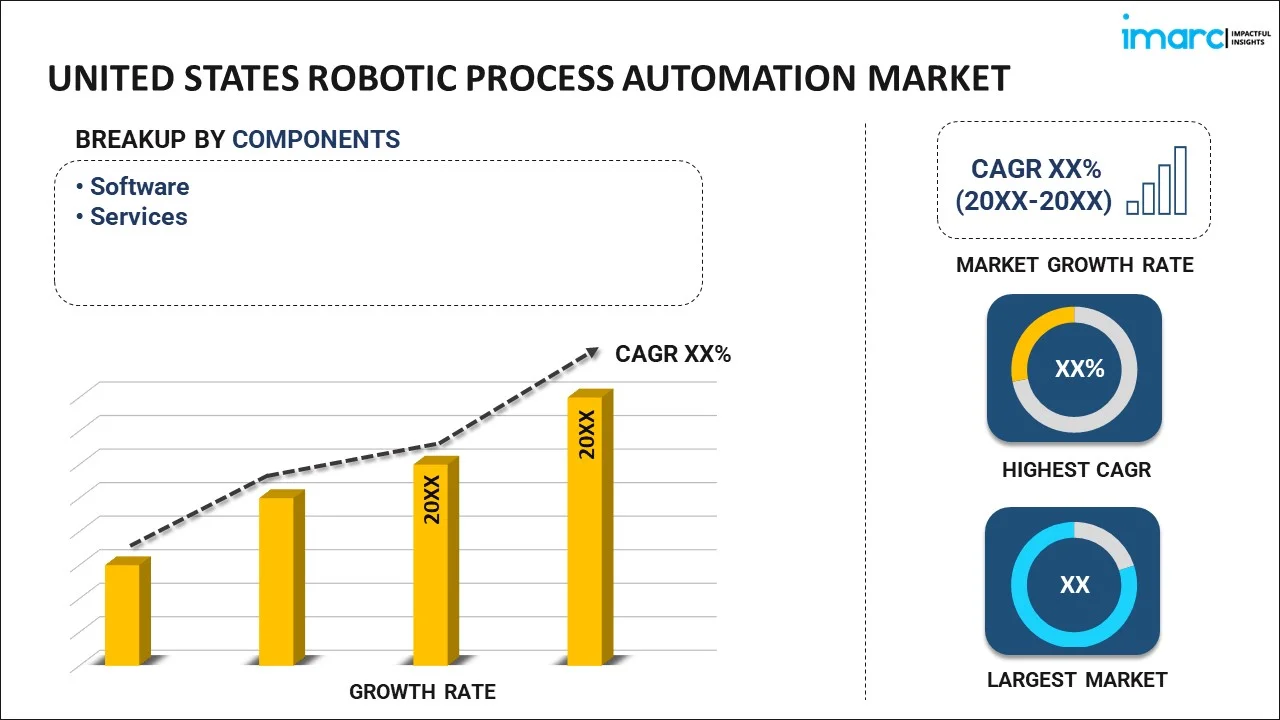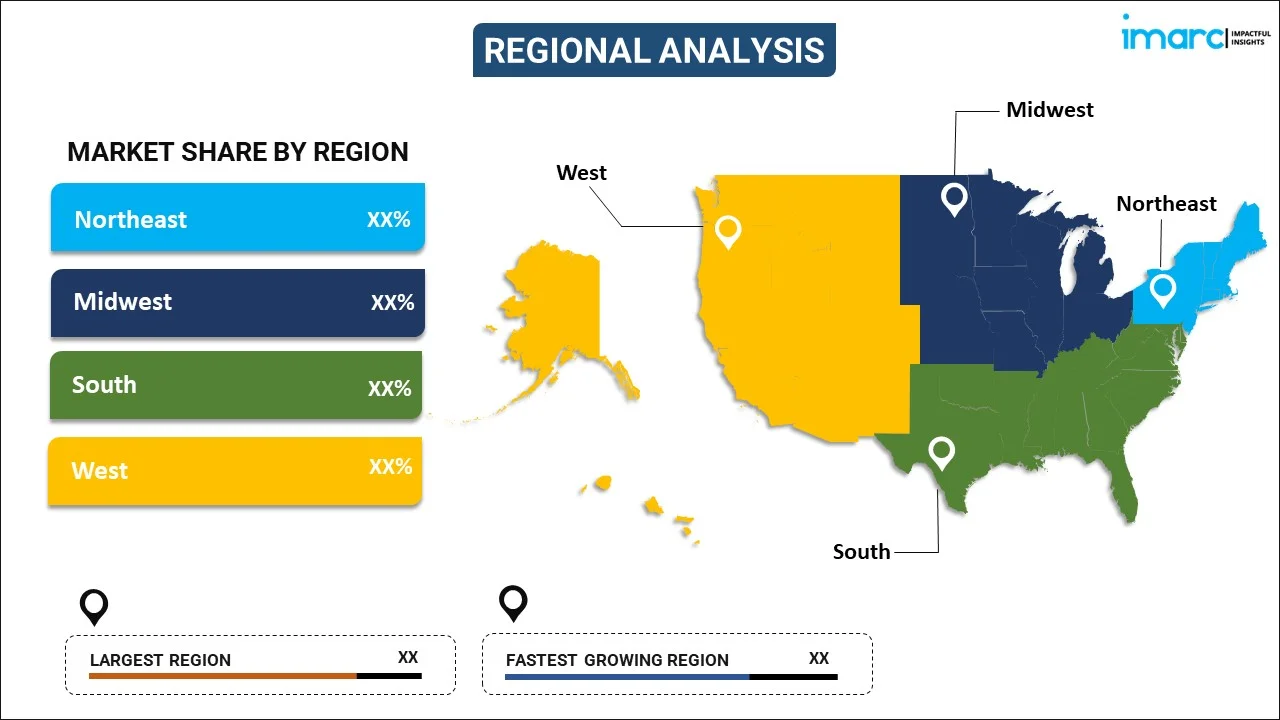
United States Robotic Process Automation Market Report by Component (Software, Services), Operation (Rule-based, Knowledge-based), Deployment Model (On-premises, Cloud-based), Organization Size (Large Enterprises, Small and Medium-sized Enterprises), End User (BFSI, Healthcare and Pharmaceuticals, Retail and Consumer Goods, IT and Telecommunication, Government and Defense, Transportation and Logistics, Energy and Utilities, and Others), and Region 2025-2033
Market Overview:
United States robotic process automation market size reached USD 1.3 Billion in 2024. Looking forward, IMARC Group expects the market to reach USD 11.3 Billion by 2033, exhibiting a growth rate (CAGR) of 27.6% during 2025-2033. The increasing demand for automating certain customer-facing processes, which can enhance the customer experience by providing quicker responses and more personalized services, is driving the market.
|
Report Attribute
|
Key Statistics
|
|---|---|
|
Base Year
|
2024 |
|
Forecast Years
|
2025-2033
|
|
Historical Years
|
2019-2024
|
| Market Size in 2024 | USD 1.3 Billion |
| Market Forecast in 2033 | USD 11.3 Billion |
| Market Growth Rate (2025-2033) | 27.6% |
Robotic process automation (RPA) is a technology that uses software robots or bots to automate repetitive and rule-based tasks within business processes. These bots mimic human actions by interacting with digital systems, applications, and data to execute tasks such as data entry, document processing, and transaction handling. RPA enhances efficiency, accuracy, and scalability in various industries, allowing organizations to streamline operations and allocate human resources to more complex and strategic activities. RPA doesn't require significant changes to existing systems, making it a cost-effective solution for automating routine tasks. It enables organizations to achieve increased productivity, reduced error rates, and faster processing times, ultimately contributing to improved overall business performance. As a transformative technology, RPA continues to evolve, offering innovative solutions to optimize workflows and enhance the agility of businesses in today's dynamic digital landscape.
United States Robotic Process Automation Market Trends:
The robotic process automation market in the United States is experiencing unprecedented growth, propelled by several key drivers. Firstly, organizations across industries are increasingly recognizing the imperative to enhance operational efficiency, reduce costs, and improve accuracy. Consequently, they are turning to RPA solutions as a means to automate routine and rule-based tasks, allowing employees to focus on higher-value activities. Additionally, the escalating volume and complexity of data in today's digital landscape demand swift and error-free data processing, a need that RPA adeptly addresses. Moreover, the advent of artificial intelligence and machine learning technologies has catalyzed the evolution of RPA, enabling it to handle more sophisticated tasks and decision-making processes. This synergy between RPA and advanced technologies not only amplifies productivity but also fosters innovation within organizations. In conclusion, the confluence of efficiency imperatives, technological advancements, and the adaptive response to regional challenges positions the RPA market on an upward trajectory. As organizations strive to stay competitive in an ever-evolving landscape, the demand for RPA in the United States is likely to intensify, fueling continuous innovation and expansion in the market.
United States Robotic Process Automation Market Segmentation:
IMARC Group provides an analysis of the key trends in each segment of the market, along with forecasts at the country level for 2025-2033. Our report has categorized the market based on component, operation, deployment model, organization size, and end user.
Component Insights:

- Software
- Services
The report has provided a detailed breakup and analysis of the market based on the component. This includes software and services.
Operation Insights:
- Rule-based
- Knowledge-based
A detailed breakup and analysis of the market based on the operation have also been provided in the report. This includes rule-based and knowledge-based.
Deployment Model Insights:
- On-premises
- Cloud-based
The report has provided a detailed breakup and analysis of the market based on the deployment model. This includes on-premises and cloud-based.
Organization Size Insights:
- Large Enterprises
- Small and Medium-sized Enterprises
A detailed breakup and analysis of the market based on the organization size have also been provided in the report. This includes large enterprises and small and medium-sized enterprises.
End User Insights:
- BFSI
- Healthcare and Pharmaceuticals
- Retail and Consumer Goods
- IT and Telecommunication
- Government and Defense
- Transportation and Logistics
- Energy and Utilities
- Others
The report has provided a detailed breakup and analysis of the market based on the end user. This includes BFSI, healthcare and pharmaceuticals, retail and consumer goods, IT and telecommunication, government and defense, transportation and logistics, energy and utilities, and others.
Regional Insights:

- Northeast
- Midwest
- South
- West
The report has also provided a comprehensive analysis of all the major regional markets, which include Northeast, Midwest, South, and West.
Competitive Landscape:
The market research report has also provided a comprehensive analysis of the competitive landscape. Competitive analysis such as market structure, key player positioning, top winning strategies, competitive dashboard, and company evaluation quadrant has been covered in the report. Also, detailed profiles of all major companies have been provided.
United States Robotic Process Automation Market Report Coverage:
| Report Features | Details |
|---|---|
| Base Year of the Analysis | 2024 |
| Historical Period | 2019-2024 |
| Forecast Period | 2025-2033 |
| Units | Billion USD |
| Scope of the Report | Exploration of Historical Trends and Market Outlook, Industry Catalysts and Challenges, Segment-Wise Historical and Future Market Assessment:
|
| Components Covered | Software, Services |
| Operations Covered | Rule-based, Knowledge-based |
| Deployment Models Covered | On-premises, Cloud-based |
| Organization Sizes Covered | Large Enterprises, Small and Medium-sized Enterprises |
| End Users Covered | BFSI, Healthcare and Pharmaceuticals, Retail and Consumer Goods, IT and Telecommunication, Government and Defense, Transportation and Logistics, Energy and Utilities, Others |
| Regions Covered | Northeast, Midwest, South, West |
| Customization Scope | 10% Free Customization |
| Post-Sale Analyst Support | 10-12 Weeks |
| Delivery Format | PDF and Excel through Email (We can also provide the editable version of the report in PPT/Word format on special request) |
Key Questions Answered in This Report:
- How has the United States robotic process automation market performed so far and how will it perform in the coming years?
- What has been the impact of COVID-19 on the United States robotic process automation market?
- What is the breakup of the United States robotic process automation market on the basis of component?
- What is the breakup of the United States robotic process automation market on the basis of operation?
- What is the breakup of the United States robotic process automation market on the basis of deployment model?
- What is the breakup of the United States robotic process automation market on the basis of organization size?
- What is the breakup of the United States robotic process automation market on the basis of end user?
- What are the various stages in the value chain of the United States robotic process automation market?
- What are the key driving factors and challenges in the United States robotic process automation?
- What is the structure of the United States robotic process automation market and who are the key players?
- What is the degree of competition in the United States robotic process automation market?
Key Benefits for Stakeholders:
- IMARC’s industry report offers a comprehensive quantitative analysis of various market segments, historical and current market trends, market forecasts, and dynamics of the United States robotic process automation market from 2019-2033.
- The research report provides the latest information on the market drivers, challenges, and opportunities in the United States robotic process automation market.
- Porter's five forces analysis assist stakeholders in assessing the impact of new entrants, competitive rivalry, supplier power, buyer power, and the threat of substitution. It helps stakeholders to analyze the level of competition within the United States robotic process automation industry and its attractiveness.
- Competitive landscape allows stakeholders to understand their competitive environment and provides an insight into the current positions of key players in the market.
Need more help?
- Speak to our experienced analysts for insights on the current market scenarios.
- Include additional segments and countries to customize the report as per your requirement.
- Gain an unparalleled competitive advantage in your domain by understanding how to utilize the report and positively impacting your operations and revenue.
- For further assistance, please connect with our analysts.
 Request Customization
Request Customization
 Speak to an Analyst
Speak to an Analyst
 Request Brochure
Request Brochure
 Inquire Before Buying
Inquire Before Buying




.webp)




.webp)












